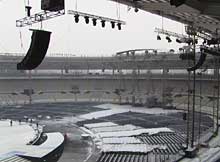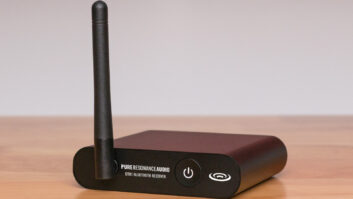
Gary Hardesty’s high-definition Panasonic line arrays were deployed to cover the stands at the Stadio Olympico in Torino, Italy.
EtherSound was the primary audio distribution and control network for both the Opening and Closing Ceremonies of this year’s Winter Olympic Games in Torino, Italy. Gary Hardesty, director of sound media fusion, designed the complex audio system, which serves multiple live audience areas and broadcast production feeds simultaneously.
“EtherSound’s low-latency audio quality and flexible functionality make it my choice for digital audio networking in these demanding special event productions,” he says. Hardesty has worked on the Super Bowl, as well as previous Olympics. He was among the first sound designers to distribute audio in digital rather than analog format, using CobraNet. This year, Hardesty switched to EtherSound to realize his sound design and audio concept for the event.
In addition to the broadcast feeds, the live audience occupies a full 360 degrees of stadium seating along with a heart-shaped VIP area on the playing field. Within that area is a separate “mosh pit” for the athletes. Each audience area had different sound reinforcement, audio program and monitoring requirements. Managing the complex project kept both Hardesty and his partner Rob Hunt busy throughout the weeks leading up to the Opening Ceremonies, with still more time devoted during the Games themselves to fine-tuning and adjustments for the gala Closing Ceremonies.
Hardesty’s main speaker system is the unusual high-definition line array he designed for Panasonic, which was first used for Athens Olympics competition venues in the summer of 2004, and is back in action at many Torino sites. For the playing field, Hardesty used Meyer Sound MILO and MICA line arrays. To provide the 300 degrees of coverage required for the 6,000 VIPs seated on the playing field, Hardesty used the line arrays in multiple zones, supplemented with 700 HP subwoofers hidden in the stage structure.

The traditional Parade of Nations, which took place early in the ceremonies, grouped the Olympic athletes in a mosh pit in the center of the VIP area. Three-box MILO line arrays left and right of the stage tower structure covered this area, with three delay zones hidden in the stage structure. These also served as key monitors for the VIP speeches delivered from the athletes’ area, such as Yoko Ono’s address.
With so many sound sources and playback locations spread out over a wide area, the Torino Olympic audio network had to be extremely robust and reliable. Hardesty’s design uses a 1 Gigabit fiber-optic backbone, with eight distribution zones supported by 1-Gigabit and 100-Megabit Cat-5e cable. Data traffic and network redundancy are managed by DLink Ethernet switches and transceivers using the Spanning Tree Protocol (STP). PCM digital audio data is transmitted across the network via EtherSound-enabled devices from Digigram.
Fifteen ES881 8-channel AES/EBU digital input EtherSound interfaces are used to transmit the source material onto the network and extract it as needed for broadcast or live sound reinforcement, along with six 8-channel analog input ES8in Ethernet audio bridges and eight analog output ES8out Ethernet audio bridges. A pair of 2-channel ES220-L EtherSound network interfaces, user-switchable as analog inputs or outputs, were also used.
Agora supplied all the equipment and Hardesty’s partner Daniele Tramontani did the detail audio network design and management for the EtherSound network with the technical support of Prase Engineering.







